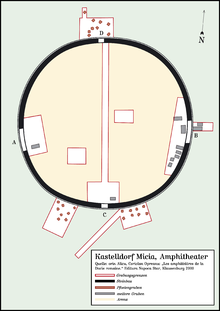- Micia (castra)
-
 Micia
MiciaKnown also as - Castra of Mintia
- Castra of Vețel
Founded 2nd century AD Abandoned c. 4th-5th century AD Place in the Roman world Roman province Dacia Administrative unit Dacia Apulensis Administrative unit Dacia Superior Nearby water Marisus Directly connected to - Germisara
- (Hunedoara)
Structure — Stone structure — Size and area 181 m x 360 m (6.5 ha) — Wood and earth structure — Stationed military units — Legions — - vexill. XIII Gemina
- vexill. IV Flavia Felix [1]
— Cohorts — II Flavia Commagenorum sagittaria [2] [1] — Alae — — Numeri — Maurorum Micensium[2] Location Coordinates 45°54′52″N 22°48′54″E / 45.9145°N 22.8149°ECoordinates: 45°54′52″N 22°48′54″E / 45.9145°N 22.8149°E Town Mintia County Hunedoara Country  Romania
RomaniaSite notes Condition Ruined Exhibitions Muzeul Civilizației Dacice și Romane, Deva
Micia was a large Roman fort for auxiliary troops and a important part of the western Dacian limes (limes Dacia). The archaeological site is located near the municipality of Vețel (Witzel), Hunedoara county in Transylvania, Romania. This Roman garrison monitored and secured the road and the river route to Partiscum, today Szeged in Hungary. In addition, there was a strategically important river port In the civil settlement, there were large baths and a small amphitheater. Significant is the large number of ancient inscriptions.Contents
Amphitheater
In the southeast of the great military bath, at a distance of about hundred meters there was found a small amphitheater. Possessed in a circle around a arena, the stone foundation of the walls had a circumference of 104 meters. The arena consisted of 31 × 29 meters.[3]
See also
External links
Notes
- ^ a b c Micia
- ^ a b c Tactică, strategie și specific de luptă la cohortele equitate din Dacia Romană, Petru Ureche
- ^ Russell L. Sturzebecker: Photo Atlas. Athletic-Cultural Archaeological Sites in the Greco-Roman World. Europe, North Africa & the Middle East. Russell L. Sturzebecker, West Chester, PA 1985. ISBN 0960046623. p. 349.
Categories:- Roman Dacia
- Archaeological sites in Romania
- Roman forts in Romania
- Dacia stubs
Wikimedia Foundation. 2010.



